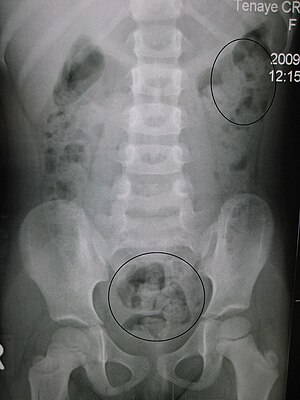Abdominal x-ray
(Redirected from Kidneys, ureters, and bladder)
Abdominal X-ray (AXR) is a widely utilized diagnostic imaging technique that plays a crucial role in the evaluation of various abdominal conditions. This non-invasive procedure involves the use of X-rays to create images of the structures within the abdomen, including the stomach, intestines, and other organs such as the liver, spleen, and kidneys. Abdominal X-rays are pivotal in diagnosing obstructions, kidney stones, free air (indicative of a perforated organ), and certain types of infections.
Indications[edit | edit source]
Abdominal X-rays are indicated for a variety of symptoms and conditions. These include, but are not limited to, acute abdominal pain, unexplained nausea and vomiting, suspected bowel obstruction or perforation, visible abdominal distension, and the evaluation of known or suspected intra-abdominal masses. They are also used in the assessment of patients with known or suspected foreign bodies within the gastrointestinal tract, and in the staging and follow-up of certain malignancies.
Procedure[edit | edit source]
The procedure for an abdominal X-ray is straightforward. The patient is typically positioned lying down on their back (supine position) on the X-ray table. In some cases, additional views may be required, such as standing or lying on the side (lateral decubitus position), to provide further information on the presence of air-fluid levels or to better visualize certain structures. The patient is instructed to remain still during the exposure to ensure the clarity of the images. The use of radiation is a concern; however, the dose is generally low and considered safe for most patients. Pregnant women or those who may be pregnant are advised to notify their healthcare provider due to potential risks to the fetus.
Interpretation[edit | edit source]
The interpretation of an abdominal X-ray requires expertise and is typically performed by a radiologist. Key aspects evaluated include the size, shape, and position of abdominal organs; the presence of abnormal gas patterns, which may indicate bowel obstruction or perforation; the visibility of soft tissues and any abnormalities therein; and the identification of calcifications, which can suggest the presence of kidney stones or other pathologies.
Limitations[edit | edit source]
While abdominal X-rays are valuable diagnostic tools, they have limitations. They may not provide detailed images of soft tissue structures when compared to other imaging modalities such as ultrasound, CT scan (computed tomography), or MRI (magnetic resonance imaging). Consequently, further imaging tests may be required to obtain a definitive diagnosis or to provide more detailed information about a particular condition.
Conclusion[edit | edit source]
Abdominal X-rays are a fundamental component of the diagnostic process for a wide range of abdominal conditions. They offer a quick and non-invasive means to assess the abdominal cavity, aiding in the diagnosis, management, and follow-up of patients with abdominal complaints. Despite their limitations, AXRs remain an essential tool in the arsenal of diagnostic imaging techniques available to healthcare providers.
Search WikiMD
Ad.Tired of being Overweight? Try W8MD's physician weight loss program.
Semaglutide (Ozempic / Wegovy and Tirzepatide (Mounjaro / Zepbound) available.
Advertise on WikiMD
|
WikiMD's Wellness Encyclopedia |
| Let Food Be Thy Medicine Medicine Thy Food - Hippocrates |
Translate this page: - East Asian
中文,
日本,
한국어,
South Asian
हिन्दी,
தமிழ்,
తెలుగు,
Urdu,
ಕನ್ನಡ,
Southeast Asian
Indonesian,
Vietnamese,
Thai,
မြန်မာဘာသာ,
বাংলা
European
español,
Deutsch,
français,
Greek,
português do Brasil,
polski,
română,
русский,
Nederlands,
norsk,
svenska,
suomi,
Italian
Middle Eastern & African
عربى,
Turkish,
Persian,
Hebrew,
Afrikaans,
isiZulu,
Kiswahili,
Other
Bulgarian,
Hungarian,
Czech,
Swedish,
മലയാളം,
मराठी,
ਪੰਜਾਬੀ,
ગુજરાતી,
Portuguese,
Ukrainian
Medical Disclaimer: WikiMD is not a substitute for professional medical advice. The information on WikiMD is provided as an information resource only, may be incorrect, outdated or misleading, and is not to be used or relied on for any diagnostic or treatment purposes. Please consult your health care provider before making any healthcare decisions or for guidance about a specific medical condition. WikiMD expressly disclaims responsibility, and shall have no liability, for any damages, loss, injury, or liability whatsoever suffered as a result of your reliance on the information contained in this site. By visiting this site you agree to the foregoing terms and conditions, which may from time to time be changed or supplemented by WikiMD. If you do not agree to the foregoing terms and conditions, you should not enter or use this site. See full disclaimer.
Credits:Most images are courtesy of Wikimedia commons, and templates Wikipedia, licensed under CC BY SA or similar.
Contributors: Prab R. Tumpati, MD

